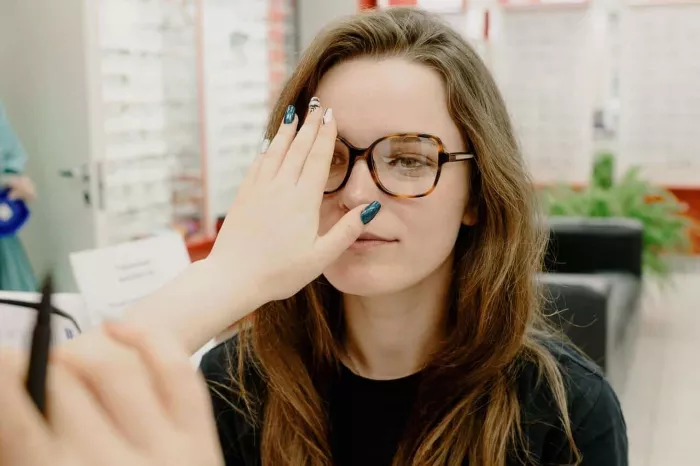Having normal vision means being able to see clearly without needing glasses or contact lenses. But what exactly is considered “normal” for each eye? Many people wonder if their left and right eyes should see equally well or if differences are normal. This article explains how vision works, what’s considered standard, and when you might need to see a doctor.
How Is Vision Measured?
Eye doctors use an eye chart called the Snellen chart to measure how well you see. The chart has rows of letters that get smaller as you read downward.
- 20/20 vision is considered normal. This means you can see at 20 feet what a person with healthy vision sees at the same distance.
- 20/40 vision means you must be 20 feet away to see what someone with normal vision can see from 40 feet.
- Better than 20/20? Some people have 20/15 vision, meaning they see at 20 feet what others see at 15 feet—this is sharper than average.
Most people have 20/20 vision, but slight variations (like 20/25) are still considered normal.
Normal Vision Differences Between Left and Right Eyes
It’s common for one eye to be slightly stronger than the other. Here’s what’s normal:
Small differences (e.g., 20/20 in one eye and 20/25 in the other) – Usually not a problem.
Larger gaps (e.g., 20/20 in one eye and 20/40 in the other) – May need glasses or contacts to balance vision.
Eye doctors test each eye separately to check for imbalances. If one eye is much weaker, it could lead to eye strain or headaches.
Why Do Eyes Have Different Vision Strengths?
Several factors can cause one eye to see better than the other:
1. Refractive Errors (Most Common Cause)
Nearsightedness (Myopia) – Difficulty seeing far away; one eye may be worse.
Farsightedness (Hyperopia) – Difficulty seeing up close; one eye may struggle more.
Astigmatism – Blurry vision at all distances due to an irregularly shaped cornea.
2. Lazy Eye (Amblyopia)
- One eye doesn’t develop properly in childhood, leading to weaker vision.
- Early treatment (patches, glasses, or exercises) can help strengthen the weak eye.
3. Eye Injuries or Diseases
- Cataracts (cloudy eye lens) can affect one eye more.
- Glaucoma (pressure damage to the optic nerve) may impact one eye first.
- Eye injuries (scratches, infections) can temporarily or permanently weaken vision in one eye.
How to Keep Both Eyes Healthy
Good vision care helps maintain balanced eyesight. Follow these tips:
Get Regular Eye Exams
- Even if you see well, yearly check-ups catch problems early.
- Children should have their first eye exam at 6 months, then at 3 years, and before starting school.
Wear Corrective Lenses If Needed
- Glasses or contacts can balance vision differences.
- If one eye is much weaker, correcting it prevents strain.
Protect Your Eyes from Injuries
- Wear safety goggles when working with tools or playing sports.
- Use UV-blocking sunglasses to prevent sun damage.
Eat Eye-Healthy Foods
- Vitamin A (carrots, sweet potatoes) supports night vision.
- Omega-3s (fish, flaxseeds) help prevent dry eyes.
- Leafy greens (spinach, kale) protect against macular degeneration.
Follow the 20-20-20 Rule for Screen Time
- Every 20 minutes, look at something 20 feet away for 20 seconds.
- Reduces digital eye strain and dryness.
When Should You See an Eye Doctor?
Schedule an appointment if you notice:
- Blurry vision in one eye (sudden or gradual)
- Double vision (seeing two images instead of one)
- Frequent headaches or eye strain
- Difficulty seeing at night
- Eye pain or redness
Early treatment can prevent long-term vision loss.
Can You Improve Vision Naturally?
While glasses or surgery fix most vision problems, some habits may help maintain eye health:
Eye exercises (like focusing on near and far objects) may reduce strain.
Quit smoking – Smoking increases the risk of cataracts and macular degeneration.
Stay hydrated – Prevents dry eyes.
However, serious vision problems need professional care—don’t rely only on home remedies.
Conclusion
Normal vision is typically 20/20, but small differences between the left and right eyes are common. If one eye is significantly weaker, glasses, contacts, or medical treatment can help. Protect your eyes with regular check-ups, a healthy diet, and proper eyewear.
Related topics:
How Much Does It Cost To Get Eye Color Surgery?
How Much Does Yag Laser Treatment For eye Veins Cost?
Is Eye Removal Surgery Painful? What to Expect


